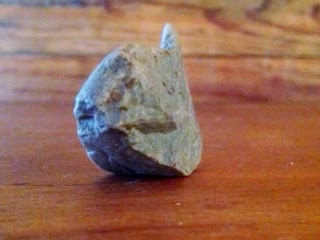Back in 2005, I noticed this stone on the same day that I found the turtle. It was quite close in proximity to it and seemed to have an unusual shape. When I picked it up, I could see that there was a rather strange-looking image that was darker than the rest of the stone.
It reminded me of a First Nations'
teepee. I have no idea whether this dark image is a natural part of the stone or if it was added by a human hand. The archaeological fellow who looked at it said it wasn't a native artifact.
If that's the case, I marvel at the fabulous job which nature has done with this particular stone and how it has created what looks like:
An animal head complete with teeth
A human face
A Face with a pointed nose, googly eyes and layers of chipping.
And one more close-up that looks a bit reptilian.
If it's the work of Mother Nature, she outdid herself in creating this particular work of art.























































